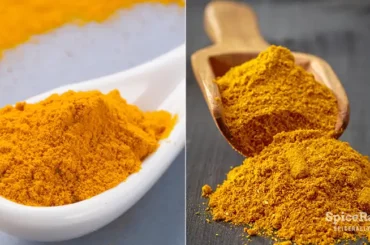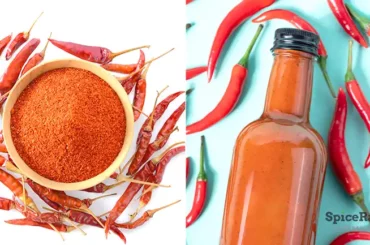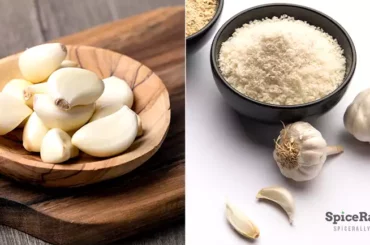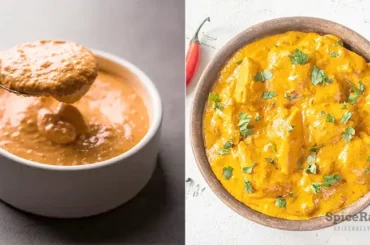Curry powder is an essential ingredient in both Sri lankan and Indian cuisines, But did you know that they use different curry powder varieties? So, here’s an elaboration on Sri lankan curry powder vs. Indian curry powder.
The key difference between Sri Lankan curry powder and Indian curry powder is the ingredients and the proportions used in each blend. Turmeric is an essential spice in Indian curry powder, but we don’t usually see it in Sri Lankan curry powder. In addition, most Sri Lankan curry powder varieties include uncooked rice, lentils, coconut, etc., for depth and color. On the contrary, these ingredients are not included in Indian curry powder.
Let’s dive in and see what else we have packed up about these two popular spice blends!

Sri Lankan Curry Powder vs Indian Curry Powder- SpiceRally DrillDown!
| Sri Lankan Curry Powder | Indian Curry Powder (Madras Curry Powder) | |
|---|---|---|
| Flavor profile | Generally, all Sri Lankan curry powder variants are warm, very spicy, earthy and, robust in flavor. It has more depth than Indian curry powder, and variations like chicken curry powder can be more piquant and flavorful. | Indian curry powder is typically spicy, flavorful, and warm. It can be earthier due to the addition of turmeric, and most variations can have a kick of heat due to the inclusion of red chiles. However, Indian curry powder is more robust than Sri lankan unroasted curry powder. |
| Base flavor | Spicy and warm | Spicy and warm |
| Ingredients | Coriander Fennel Cumin Fenugreek seeds Black mustard seeds Cloves Green cardamom Ceylon cinnamon Black pepper Curry leaves Pandan leaves Uncooked rice Coconut Mysore dal Chana dal Sesame seeds Some variations might also include the following: Lemongrass Garlic Ginger Nutmeg Mace Dried red chiles | Coriander Cloves Fennel Ground turmeric Cumin Black peppercorns Fenugreek seeds Mustard seeds Cinnamon Dried or powdered Kashmiri red chiles May also include the following: Bay leaves Asafoetida Cardamom Curry leaves |
| Texture | A fine powder | A fine powder |
| Heat and spiciness | Heat and spiciness vary depending on each variation. | Heat and spiciness vary, depending on each variation. |
| Color | – Roasted curry powder is a deep, rich brown, while unroasted curry powder is light brown. – Chicken curry powder has a brownish-black tone, and Jaffna curry powder also holds a deep brown hue. – The color of roasted curry powder variants depends on the roasted depth of coconut and added grains. | The color of Indian curry powder can range from light brown to dark brown, depending on the ingredients used. |
| Mode of usage in cooking | As an ingredient in cooking and as a finishing spice. | As an ingredient in cooking and as a finishing spice. |
| Usage in cooking | – Mainly used in making curries. – Unroasted curry powder is ideal for making vegetable dishes. – Spices up meat, fish, and seafood dishes. – It can be added to gravies and curry sauces. – Works as a base for marinades and rubs. | – Primarily used to add flavor to curries. – Milder versions complement vegetable dishes, while hot curry powder is paired with meat, fish, and seafood recipes. – Ramps up lentil dishes. – It can be added to spice up rice recipes. – Flavors up stews, soups, and broths. |
| Origin | Sri Lankan cuisine | Indian cuisine |
| Mode of production | Both domestic and commercially made options exist. | Both domestic and commercially made options exist. |
| Availability | – Widely available in Sri Lankan shops but can be challenging to find outside of Sri Lankan in the western market. – It can be bought through online vendors and available in Asian stores or the international spice aisle of the supermarket. | It can be purchased from the international spice aisle of the supermarket, online shopping sites, and Asian groceries under several brand names. |
| Storage | – It should be stored in tightly-fitting containers in a cool, dark, dry place. – It can be kept with the rest of the spices in your spice cabinet. Refrigeration is not required. | – It should be stored in tightly-fitting containers in a cool, dark, dry place. – It can be kept with the rest of the spices in your spice cabinet. Refrigeration is not required. |
| Culinary ingredient category | Spice blend/ mixture | Spice blend/ mixture |
More Insights Into The Difference Between Sri Lankan Curry Powder And Indian Curry Powder
Curry is the heart of Indian and Sri Lankan cuisines. Natives living in these countries usually have curries daily with their regular meals. Thus, curry powder is closely associated with both their cultures and food. However, every type of curry powder is different.
Accordingly, you can see some apparent differences between Sri Lankan curry powder and Indian curry powder. Primarily, curry powder is not the main spice blend of Indian cuisine since they tend to put Garam Masala over anything! But on the contrary, curry powder is everything for the Sri Lankans as they use this spice blend with the bulk of their regular dishes.
Indian curry powder also goes by the name of Madras curry powder in India. You’ll find plenty of unnamed variations of Indian curry powder depending on the household or region, just like the Sri lankan curry powder. But, there are named variations of Sri Lankan curry powder such as roasted, unroasted, chicken curry powder, and Jaffna curry powder.
Furthermore, the addition of turmeric, bay leaves, and star anise is prevalent in Indian curry powder. These ingredients are not typically added to Sri Lankan curry powder. But instead, it has pandan leaves, uncooked rice, coconut, sesame seeds, and one or two types of lentils. Apart from these significant differences, the usage of both types of curry powder is similar in both cuisines.
Can We Use Indian Curry Powder In Place Of Sri Lankan Curry Powder And Vice Versa?
Differences apart, Indian curry powder can be an excellent substitute for Sri Lankan curry powder and vice versa. Both spice blends share some fundamental ingredients, comparing the flavor profile. However, it is essential to remember that Indian curry powder could be less robust than Sri Lankan curry powder.
But this difference will not affect much for the dishes that call for Sri Lankan curry powder as a secondary ingredient. For example, hot Madras curry powder can preferably be used instead of Sri Lankan chicken curry powder or roasted curry powder in meat curries.
Likewise, you can use roasted, Jaffna, or chicken curry powder varieties instead of Indian curry powder to be substituted in Indian recipes. But, Sri Lankan unroasted curry powder can be less piquant and flavorful since it is milder than Indian curry powder.




